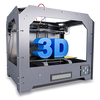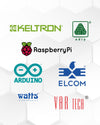
What Are Transistors and Why Are They Important?
Take apart any electronic device; a phone, a laptop, a microwave, or even a remote-controlled toy, and somewhere inside, you’ll find tiny components doing all the hard work. One of the most important of them is the transistor.
So, what is a transistor? Why do people call it the building block of modern electronics? And how does such a tiny thing power everything from blinking LEDs to powerful AI chips?
Let’s break it down in plain language.
What Is a Transistor?
A transistor is a tiny electronic component that acts like a switch or amplifier for electrical signals.
Think of it like a gate. Depending on how much voltage or current you apply to it, it either:
-
Allows electricity to flow through a circuit (switch ON)
-
Blocks electricity (switch OFF)
-
Or boosts a signal, making weak signals stronger (amplifier)
It has three legs (or pins):
-
Base (B) – the control input
-
Collector (C) – current flows in here
-
Emitter (E) – current flows out here
When a small current is applied to the base, it allows a larger current to flow between the collector and emitter. It’s a bit like using your finger (base) to flip a water valve (collector-emitter) and control a much bigger flow.
Types of Transistors
There are two main families of transistors:
1. BJT (Bipolar Junction Transistor)
-
Controlled by current to the base
-
Common types: NPN and PNP
-
Great for basic switching and analog amplification
Example: You can use an NPN transistor to turn on an LED using a small signal from an Arduino pin.
2. MOSFET (Metal Oxide Semiconductor Field Effect Transistor)
-
Controlled by voltage at the gate
-
Has three pins: Gate, Drain, Source
-
More efficient at switching, especially for high-power applications
Use case: MOSFETs are found in everything from motor drivers to power supplies to CPUs.
3. IGBT (Insulated Gate Bipolar Transistor)
-
A hybrid of BJT and MOSFET: combines the easy control of a MOSFET with the high-current handling of a BJT
-
Perfect for high-voltage, high-power applications
-
Often used in inverters, electric vehicles, induction heaters, and industrial motor drives
Use case: Drive a large AC motor or control an industrial heating coil efficiently with high voltage and current.
Why it’s awesome:
-
Handles hundreds of volts and amps
-
Efficient at switching very large loads
Why Are Transistors So Important?
Transistors are the foundation of modern electronics. Here’s what they do:
1. Logic and Processing
Digital electronics (like microcontrollers and CPUs) work by turning transistors ON and OFF billions of times per second. These create the binary 1s and 0s that run your phone, computer, and smart gadgets.
2. Signal Amplification
In audio systems, microphones, or radios, transistors boost weak signals into something usable, turning whispers into sound waves you can hear.
3. Switching Power Loads
Want to control a fan, a 12V light, or a water pump using a 3.3V or 5V signal? A transistor makes that happen safely, acting as a smart power relay.
4. Efficient Power Conversion
IGBTs and power MOSFETs are essential in converting battery power to usable AC current in inverters, solar panels, and electric vehicles.
Transistors in Chips and Circuits
A modern microprocessor (like in your phone or computer) can contain up to 100 billion transistors, all etched into a silicon chip just a few centimeters wide.
Each transistor is a tiny switch that turns on or off incredibly fast; this is how calculations happen.
IGBTs, on the other hand, are not miniaturized like that. They’re big, powerful, and designed to drive real-world energy like moving a train or running a factory motor.
Hands-On: Control a Motor with a Transistor
You can use a NPN BJT or an N-channel MOSFET to turn a DC motor on/off with your microcontroller.
Basic Setup:
-
Connect the motor’s negative side to the collector/drain
-
Base/gate connected to your control pin (with a resistor)
-
Emitter/source to ground
-
Don’t forget a flyback diode to protect against voltage spikes!
Watch Out for These Common Mistakes
-
❌ No base/gate resistor – may burn out your microcontroller or transistor
-
❌ Wrong transistor for the job – don’t use a BJT where a power MOSFET is needed
-
❌ Overheating – always check current and use a heatsink or fan if needed
-
❌ Reversing pins – always read the datasheet!
|
Application |
Transistor Type |
Purpose |
|
Arduino LED Blink |
BJT (NPN) |
Switches LED with GPIO pin |
|
Robot Motor Driver |
MOSFET |
Controls motor speed with PWM |
|
Smartphone CPU |
MOSFET (billions) |
Forms logic circuits inside the chip |
|
Electric Car Inverter |
IGBT |
Converts DC battery power to drive motors |
|
Audio Amplifier |
BJT or MOSFET |
Amplifies microphone or music signals |
Final Thoughts
Transistors may be small, but they’re everywhere and incredibly powerful.
-
Use BJTs for basic control and amplification
-
Use MOSFETs for efficient power switching in most DC projects
-
Use IGBTs when you’re dealing with very high voltage/current, like motors, EVs, or AC control systems
They form the core of modern electronics, and once you understand them, you unlock a whole new world of what’s possible with your projects.



